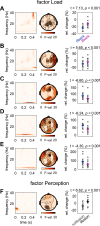Memory Load Alters Perception-Related Neural Oscillations during Multisensory Integration
- PMID: 33310755
- PMCID: PMC7896008
- DOI: 10.1523/JNEUROSCI.1397-20.2020
Memory Load Alters Perception-Related Neural Oscillations during Multisensory Integration
Abstract
Integrating information across different senses is a central feature of human perception. Previous research suggests that multisensory integration is shaped by a context-dependent and largely adaptive interplay between stimulus-driven bottom-up and top-down endogenous influences. One critical question concerns the extent to which this interplay is sensitive to the amount of available cognitive resources. In the present study, we investigated the influence of limited cognitive resources on audiovisual integration by measuring high-density electroencephalography (EEG) in healthy participants performing the sound-induced flash illusion (SIFI) and a verbal n-back task (0-back, low load and 2-back, high load) in a dual-task design. In the SIFI, the integration of a flash with two rapid beeps can induce the illusory perception of two flashes. We found that high compared with low load increased illusion susceptibility and modulated neural oscillations underlying illusion-related crossmodal interactions. Illusion perception under high load was associated with reduced early β power (18-26 Hz, ∼70 ms) in auditory and motor areas, presumably reflecting an early mismatch signal and subsequent top-down influences including increased frontal θ power (7-9 Hz, ∼120 ms) in mid-anterior cingulate cortex (ACC) and a later β power suppression (13-22 Hz, ∼350 ms) in prefrontal and auditory cortex. Our study demonstrates that integrative crossmodal interactions underlying the SIFI are sensitive to the amount of available cognitive resources and that multisensory integration engages top-down θ and β oscillations when cognitive resources are scarce.SIGNIFICANCE STATEMENT The integration of information across multiple senses, a remarkable ability of our perceptual system, is influenced by multiple context-related factors, the role of which is highly debated. It is, for instance, poorly understood how available cognitive resources influence crossmodal interactions during multisensory integration. We addressed this question using the sound-induced flash illusion (SIFI), a phenomenon in which the integration of two rapid beeps together with a flash induces the illusion of a second flash. Replicating our previous work, we demonstrate that depletion of cognitive resources through a working memory (WM) task increases the perception of the illusion. With respect to the underlying neural processes, we show that when available resources are limited, multisensory integration engages top-down θ and β oscillations.
Keywords: multisensory integration; sound-induced flash illusion; top-down; working memory; β oscillations; θ oscillations.
Copyright © 2021 the authors.
Figures





References
Publication types
MeSH terms
LinkOut - more resources
Full Text Sources
Medical
